ISSN ONLINE(2319-8753)PRINT(2347-6710)
ISSN ONLINE(2319-8753)PRINT(2347-6710)
Shahzad Jamil Sardar and Umesh. N. Karadi
|
| Related article at Pubmed, Scholar Google |
Visit for more related articles at International Journal of Innovative Research in Science, Engineering and Technology
Shear wall is a structural element used to resist horizontal forces parallel to the plane of the wall. Shear wall has highiy in plane stiffness and strength which can be used to simultaneously resist large horizontal loads and support gravity loads. Shear Walls are specially designed structural walls include in the buildings to resist horizontal forces that are induces in the plane of the wall due to wind, earthquake and other forces. They are mainly flexural members and usually provided in high rise buildings to avoid the total collapse of the high rise buildings under seismic forces. In this project, study of 25 storeys building in zone V is presented with some investigation which is analyzed by changing various location of shear wall for determining parameters like storey drift, storey shear and displacement is done by using standard package ETAB. Creation of 3D building model for both linear static and linear dynamic method of analysis and influence of concrete core wall provided at the center of the building.
Keywords |
| Shear wall, lateral loading, Equivalent static, Response Spectrum method. |
INTRODUCTION |
| RC multi-storey buildings are adequate for resisting both the vertical and horizontal load. When such building is designed without shear wall , beam and column sizes are quite heavy and there is problem arises at these joint and it is congested to place and vibrate concrete at these places and displacement is quite heavy which induces heavy forces in building member. Shear wall may become essential from the point of view of economy and control of horizontal displacement. Kasliwal Sagar K.et al(2) considered two multi storey buildings, both are sixteen storey have been modeled using software package ETABS for earthquake V zone in India. Different position and location of shear walls are considered for studying their effectiveness in resisting lateral forces. This paper also deals with the Dynamic linear Response spectra method and static method on multi-storey shear wall building with variation in number and position of shear wall. Based on the analysis results they found that as per the analysis storey drift in the Model M2 is less than Model M1.For earth quake forces in X and Y direction i.e. EQX and EQY shows that Story Drift along Y is larger than along X for M2. Story drift in model M1 is larger than model M2 ,Story Drift due to SPECX and SPECY is along Y is larger than along X .also story drift in model M1 is larger than model M2 Story. Show that base shear obtained in response spectra in X is larger than Y i.e. (spec X > spec Y.) for both model M1 & M2 and also base shear obtain in Response spectra for M2 is larger than M1. Thus shear walls are one of the most effective building elements in resisting lateral forces during earthquake. By providing shear walls in proper position can be minimized effect and |
| damages due to earthquake and winds. P. S. Kumbhare, A. C. Saoji(3) the scope of present work is to study the effect of seismic loading on placement of shear wall in medium rise building at different alternative location. The residential medium rise building is analyzed for earthquake force by considering two type of structural system.i.e. Frame system and Dual system. Effectiveness of shear wall has been studied with the help of four different models. Model one is bare frame structural system and other four models are dual type structural system. Analysis is carried out by using standard package ETAB. The comparison of these models for different parameters like Displacement, Storey Drift and Story Shear has been presented by replacing column with shear wall. Based on the analysis results they found that from result observed that the displacement of Model II, Model V reduced up to 20-30 % as compared with bare frame model. where as in model III and IV maximum displacement also reduced up to 30-50 % as compared with bare frame. From result observed that drift is increased as height of building increased and reduced at top floor. From above results it is clear that shear wall frame interaction systems are very effective in resisting lateral forces induced by earthquake. Placing shear wall away from center of gravity resulted in increase in the most of the members forces. It follows that shear walls should be coinciding with the centroid of the building |
| Anuj Chandiwala(4) considered five different models of 10-storey RC residential building located in india in seismic zone III and founded on medium soil, which is the reference ground condition. The structural configuration and dimension of the building structure are shown in Figures 3 to7 and 9. In this case the earthquake force is predominant then the calculated wind pressure, hence the structure is analyzed & designed for the seismic loading only. Based on the analysis results they found that after the analysis of the different position of shear wall in the building configuration following is the comparison in maximum base shear in X & Y-direction. It is shown in the graph fig. 8 and the Values of the base shear is given. From the analysis of the building configuration, it is concluded that option-I is best suited for the base shear during earthquake. |
II. MATERIALS AND METHODS |
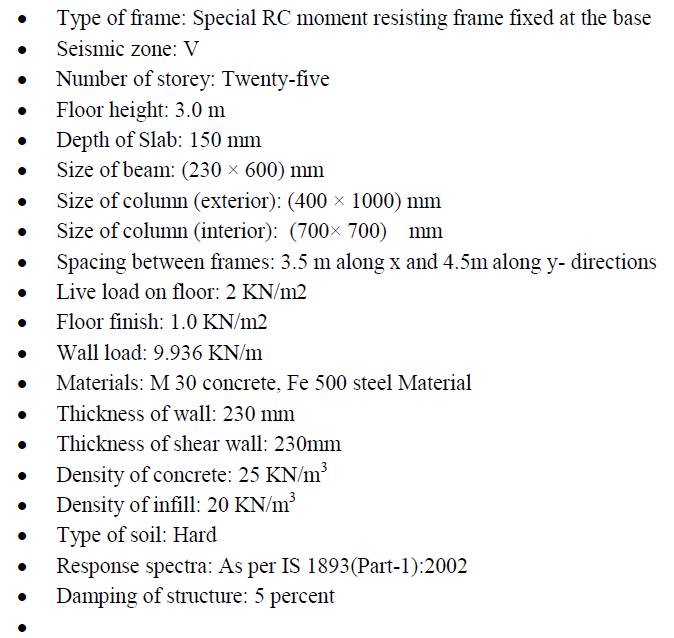 |
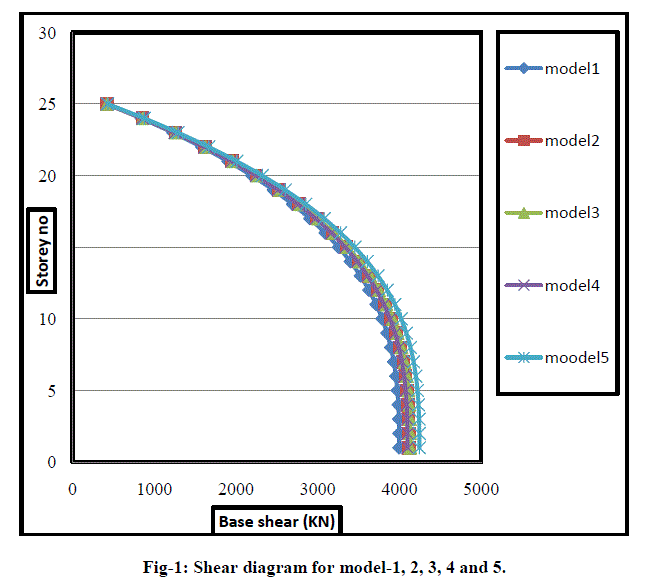 ' ' |
III. RESULT AND DISCUSSION |
| The seismic analysis of all the frame models that includes different location of shear walls has been done by using software ETABS and the results are shown below. The parameters which are to be studied are inter-storey drift, base shear and lateral displacement. |
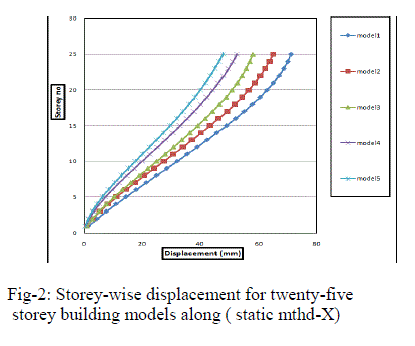 |
| The seismic base shear for building, it has been found that maximum base shear in model-5 along longitudinal and transverse direction as compared to the model-1 and it has been found that model-1, model-2, model-3 and model- 4 has 5.82% ; 3.06% ; 2.62% and 3.37% respectively shows lesser seismic base shear as compared to the model-5 in longitudinal and transverse direction. |
 |
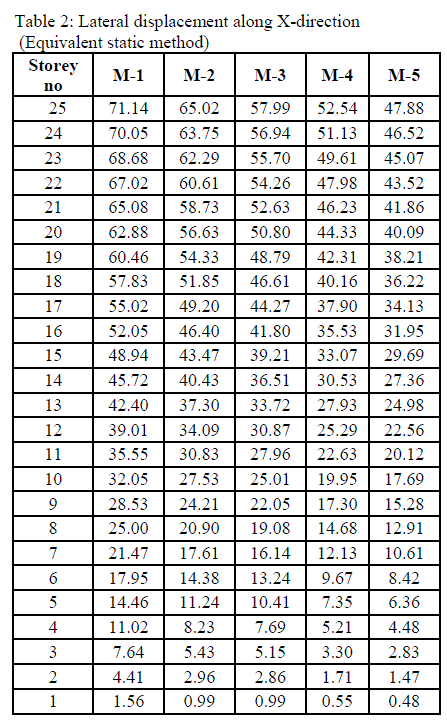 |
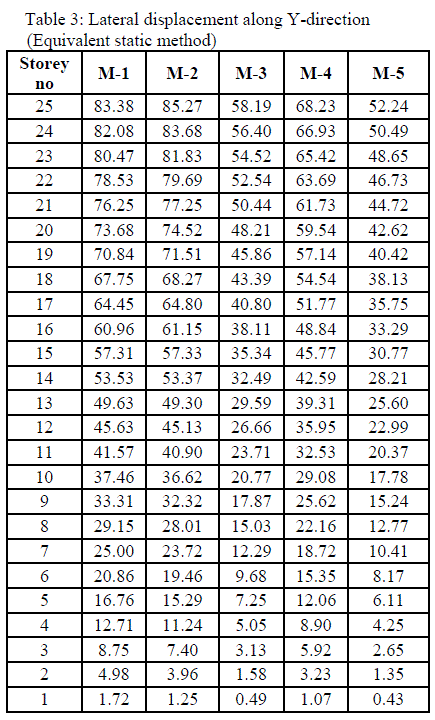 |
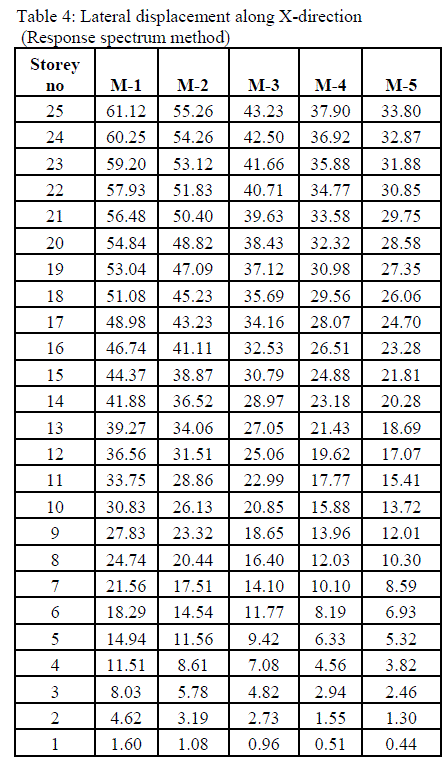 |
IV. CONCLUSION |
| 1. The seismic analysis of reinforced concrete frame structure is done by both static and dynamic analysis to determine and compare the base shear; it has been found that maximum base shear in model-5 along longitudinal and transverse direction as compared to the other models. |
| 2. In equivalent static analysis it has been found that model-5 shows lesser displacement as compared to other models in longitudinal direction. In response spectrum analysis model-5 shows lesser displacement as compared to other models in longitudinal direction. In equivalent static analysis it has been found that model-5 shows lesser interstorey drift as compared to other models in longitudinal direction. In response spectrum analysis model-5 shows lesser inter-storey drift as compared to other models in longitudinal direction. |
| 3. The presence of shear wall can affect the seismic behavior of frame structure to large extent, and the shear wall increases the strength and stiffness of the structure.It has been found that the model-5 shows better location of shear wall since lateral displacement and inter-storey drift are less as compared to other models. |
| In case of shear wall at exterior corners the structure is subjected to less displacement against the structure with shear wall at Centre. From the above study we conclude that model-5 shows better performance among the other models. |
References |
|